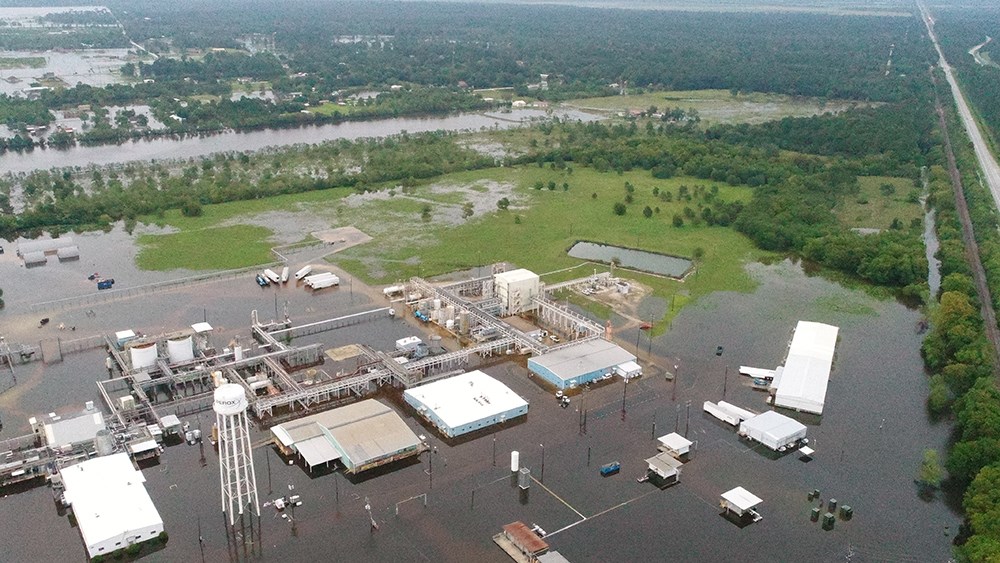The Arkema chemical plant in Texas flooded and exploded after Hurricane Harvey.
Recently, an investigation by the Associated Press and the Houston Chronicle revealed that the toxic effects left behind by Hurricane Harvey in the Houston region were far worse than what the local authorities and the fossil fuel industry initially reported in late August.
From the investigation:
Some 500 chemical plants, 10 refineries and more than 6,670 miles of intertwined oil, gas and chemical pipelines line the nation’s largest energy corridor. Nearly half a billion gallons of industrial wastewater mixed with storm water surged out of just one chemical plant in Baytown, east of Houston on the upper shores of Galveston Bay.
Benzene, vinyl chloride, butadiene and other known human carcinogens were among the dozens of tons of industrial toxic substances released into surrounding neighborhoods and waterways following Harvey’s torrential rains. In all, reporters catalogued more than 100 Harvey-related toxic releases — on land, in water and in the air. Most were never publicized, and in the case of two of the biggest ones, the extent or potential toxicity of the releases was initially understated.
For local Sierra Club organizer Bryan Parras, this was no surprise. “To me, this was expected and something I had been saying since day one, because the local industry has a long track record of under-reporting releases, spills, and leaks,” said Parras, an organizer with the Sierra Club’s Beyond Dirty Fuels campaign ad co-founder and board member of t.e.j.a.s., Texas Environmental Justice Advocacy Services. “This has gone on for decades and is well- known.”
What’s more, Texas Governor Greg Abbott only just lifted a waiver on environmental safeguards lifted after Harvey hit, an issue Parras and community groups had been requesting for months.
Parras has been working tirelessly with others to try to keep this toxic aftermath in the public eye and to hold officials and the companies accountable. He’s appeared several times on Democracy Now and in local news outlets to raise awareness.
As he said, it’s part of the region’s toxic track record.
“We also know that these same facilities regularly have ‘upsets’ and illegally dump thousands of tons of chemicals into the air routinely during emergency ‘shutdowns’ and ‘start-ups,” said Parras. “Harris County has the most pipeline leaks in the nation, and many of the emissions from these go unreported and undetected.”
According to the investigation by the AP and the Houston Chronicle:
Based on widespread air monitoring, including flyovers, officials repeatedly assured the public that post-Harvey air pollution posed no health threat. But the U.S. Environmental Protection Agency official in charge now says these general assessments did not necessarily reflect local ‘hotspots’ with potential risk to people.
The article details the health issues of several residents due to nearby toxic spills during Harvey. Parras said many more steps must be taken. He encourages people to keep holding their elected officials and environmental agencies on the local, state, and federal level accountable because the companies must be held responsible for their lack of action during and after the storm:
With a few exceptions, companies with spills did not call local emergency responders, meaning the public was not informed in real time. Instead, the companies handled the spills in-house, the Chronicle and AP found in surveying local and county fire officials. The Harris County Sheriff’s Office, which handles countywide emergency response and routinely dispatches a special investigator to major spills, said it was not alerted to 22 of 23 spills that reporters asked about, based on size and potential toxicity.
“We need legal action for illegal dumping that took place during the storm,” said Parras. “We need a public health survey and assessment done all along the Houston Ship Channel and in other areas like Port Arthur, Beaumont, and around Arkema where communities were also exposed to chemical releases.”
Parras’ has lived in the heavily industrialized communities around Houston for years and has seen the toxic effects in his own life. His family suffers from several autoimmune diseases and chronic respiratory and skin conditions - and he’s seen many of his neighbors coping with the same problems.
He hopes this latest report about the storm’s aftermath can bring about positive change. Houston’s recovery from Harvey could be an influence for how the clean-up of a toxic legacy is conducted in other areas of the U.S, said Parras. “Currently, Houston is the problem, but it can be part of the solution into a just transition away from fossil fuels.”
